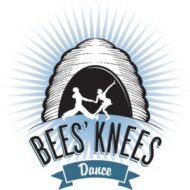Happy Pride! In celebration of inclusivity and openness within the swing dance community, here are some of my thoughts on gender roles within swing dancing.
The swing dance community is very supportive of the idea that the dance roles of following and leading are not inherently tied to female and male gender roles. But even with the best intentions, it can be challenging to support this in real life. That’s sort of the whole “point” of internalized ideas – they feel normal and logical until you really shine a light on them. It’s not enough to assume that you are supporting gender diversity within dance unless you take the time to educate yourself, and to critically examine your assumptions and actions.
And hey – even if you have good intentions, and put in that time, we’re all going to run into situations where we don’t know the “right” answer, where we don’t come to the “right” answer in time, or where there is no “right” answer at all. This is *especially* true in swing dancing. We are trying to reproduce a dance that comes from an era with specific expectations attached to gender. We want to be true to the original spirit of the dance… except the gender roles part… guys, this is hard!
I’ve compiled below some “sticky situations” that I’ve come across, where I didn’t exactly know how to handle a situation. Sticky in a good way! Working through tricky situations is how we learn.
Telling stories in choreography
Situation: All of the performers in a choreographed number are dancing the traditional role based on their gender. While choosing outfits for the performance, followers are asked to wear skirts and leaders are asked to wear pants and a vest. Everyone is wearing something that they already own and are comfortable wearing. Easy right? Well, not entirely. People should be able to choose their dance role without that choice being attached to gender-specific clothing. This came up for me personally at the most recent Bees’ Knees Dance show. In one number, I was leading but wore a dress, as this was the easiest way for me personally to fit in with a “dressy” theme. I didn’t feel pressured to dress “like a man” just because I was leading. Yay! Another number (which I helped to choreograph) had a WWI theme, something along the lines of “a last hurrah before the soldiers head off to war”. This was more difficult to navigate. The leaders were dressed in a military theme. The followers were dressed as “loved ones saying goodbye”. The followers were all women, and all chose to wear dresses. I would have been completely open to a follower choosing a more gender-neutral or “masculine” outfit, but it didn’t come up – and, the choice of dress did help to create the historical picture. Using traditional storylines with traditional gender roles makes it easier to tell stories through dance. One of my personal goals is to tell stories through choreography without attaching dance roles to gender roles.
But they want to be traditional!
Situation: After hearing about leading and following in gender-neutral terms in a beginner lindy hop class, a man chooses the follower role. This is good, as a teacher I’m actively trying to de-emphasize the “normal” role, and to normalize role choice! Yay! However, most of the class has chosen the traditional role based on their gender (maybe they have cultural knowledge suggesting that leaders are men and followers are women). After a few rotations, it “clicks” for the man who is following that he is dancing a non-traditional role. He didn’t actively choose to be “non-traditional.” The hypothetical person in this situation would prefer to dance with women most of the time, and is uncomfortable in the role he has chosen. There are two common outcomes in this situation: the person in question feels uncomfortable and never comes back, or they try to switch roles mid-class causing footwork mayhem. I have some strategies that help in this situation, but whether or not I should give beginners some context about the most common dance role for each gender is something that I’ve never fully resolved.
You don’t know the full story
Situation: During class rotation, one of the leaders refuses to dance with a particular follower. My reaction would be to take the leader in question aside to explain that it is disruptive and unfair to refuse to dance with a particular person in rotation, and give them them the option of re-entering the class or allowing them to leave the class with a full refund. This seems like a clear solution, but there are things I struggle with. You never know the full story behind personal relationships. Perhaps these individuals had a negative social interaction outside of class, which made the leader in question feel unsafe with this partner. Maybe there is a dance issue, where the person refusing the dance feels like their partner was rough or somehow dangerous to dance with. I am an advocate for personal space on the social dance floor – I often counsel people that while swing dancing culture involves accepting most dances and dancing with a diversity of people, you never have to accept a dance and that you are always in control of your personal space. In principle, this seems to conflict with my decision to “force” people to dance with each other in rotation. However, attending a swing dance class means that you are opting in to a situation where you will be rotating partners, and the instructor has a responsibility to create an inclusive environment in the classroom. They also have the responsibility of creating a safe environment – a good instructor will pay careful attention to people’s dancing to correct any behaviours that could be dangerous or uncomfortable. This situation is one where I feel confident about the action that should be taken, but acknowledging that people may have different reasons for refusing to dance with someone can make it challenging to implement.
Some other resources
A lot has been written about the topic of gender and dance roles in swing dancing. I really like the work presented here by Rebecca Brightly, here by Dogpossum and I personally rely on the Safe Space Guidelines written by Toronto’s Swingin’ Out.
Feedback
Thanks for reading! Have something to suggest for my sticky situations? I’d love to hear what you have to say in the comments below.


